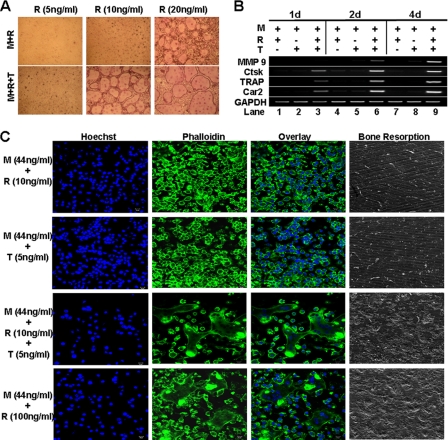FIGURE 2.
TNF can induce osteoclastogenesis and activate osteoclast genes in the presence of permissive levels of RANKL. A, BMMs were cultured with 44 ng/ml M-CSF (M) plus different doses of RANKL (R) with or without TNF (T, 5 ng/ml) for 4 days (d) in a tissue culture dish. The cultures were then stained for TRAP activity. B, BMMs were treated with M-CSF (44 ng/ml) and RANKL (10 ng/ml), M-CSF (44 ng/ml) and TNF (5 ng/ml), or M-CSF (44 ng/ml) + RANKL (10 ng/ml) + TNF (5 ng/ml) for 1, 2, or 4 days. Gene expression was determined by semiquantitative RT-PCR. C, BMMs on bone slices were treated with M-CSF (44 ng/ml) and RANKL (10 ng/ml), M-CSF (44 ng/ml) and TNF (5 ng/ml), M-CSF (44 ng/ml) + RANKL (10 ng/ml) + TNF (5 ng/ml), or M-CSF (44 ng/ml) and RANKL (100 ng/ml) for 4 days, and bone slices were stained with Hoechst 33258 (Hoechst) or Alexa Fluor 488 phalloidin (Phalloidin). A separate set of cultures was continued for 4 additional days to perform bone resorption assays.

